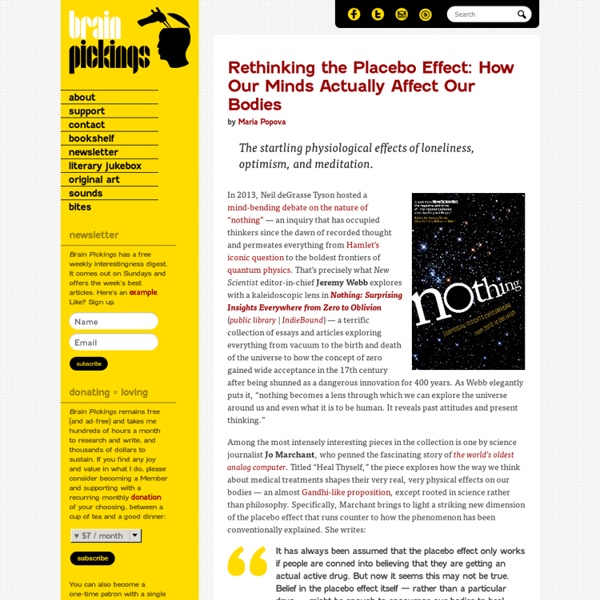Rethinking the Placebo Effect: How Our Minds Actually Affect Our Bodies

Sam Harris on the Paradox of Meditation and How to Stretch Our Capacity for Everyday Self-Transcendence
Montaigne believed that meditation is the finest exercise of one’s mind and David Lynch uses it as an anchor of his creative integrity. Over the centuries, the ancient Eastern practice has had a variety of exports and permutations in the West, but at no point has it been more vital to our sanity and psychoemotional survival than amidst our current epidemic of hurrying and cult of productivity. It is remarkable how much we, as a culture, invest in the fitness of the body and how little, by and large, in the fitness of the spirit and the psyche — which is essentially what meditation provides. In Waking Up: A Guide to Spirituality Without Religion (public library), neuroscientist and philosopher Sam Harris argued that cultivating the art of presence is our greatest gateway to true happiness. Harris writes: We know that the self is a social construct and the dissolution of its illusion, Harris argues, is the most valuable gift of meditation:
Research Mapping Human Emotions Shows Strong Mind Body Connection
Photo: Bodily topography of basic (Upper) and nonbasic (Lower) emotions associated with words. The body maps show regions whose activation increased (warm colors) or decreased (cool colors) when feeling each emotion. (P < 0.05 FDR corrected; t > 1.94). The color bar indicates the t-statistic range. Love makes us warm all over, and now scientists are creating body maps to prove it. A team of scientists in Finland has used a topographical self-reported method to reveal the effects that different emotional states have on bodily sensations. Most basic emotions were associated with sensations of elevated activity in the upper chest area, likely corresponding to changes in breathing and heart rate (1). Research on behavioral and physiological responses to emotions could help in understanding mood disorders such as anxiety and depression. “Emotions coordinate our behavior and physiological states during survival-salient events and pleasurable interactions. About the Author Credits: WakingTimes.
Jack Kerouac on How to Meditate
Frequencies of Brilliance - Enter Doorways to Remembrance of YOUR Unlimited Self
How Buzz Aldrin's communion on the moon was hushed up | Matthew Cresswell
Neil Armstrong will be remembered at Washington National Cathedral today. It's a good moment to look at one eccentric Apollo story: the tale of Aldrin's hushed-up communion on the moon. Before Armstrong and Aldrin stepped out of the lunar module on July 20, 1969, Aldrin unstowed a small plastic container of wine and some bread. He had brought them to the moon from Webster Presbyterian church near Houston, where he was an elder. Aldrin had received permission from the Presbyterian church's general assembly to administer it to himself. He then ate and drank the elements. He also read a section of the gospel of John. The story of the secret communion service only emerged after the mission. After the Apollo 8 crew had read out the Genesis creation account in orbit, O'Hair wanted a ban on Nasa astronauts practising religion on earth, in space or "around and about the moon" while on duty. And as for O'Hair? But in a sense, she need not have worried.
Chakras
undefined Chakras - our 'invisible' organs Back to Breatharian page Since chakras showed to have such a vital part in breatharianism, I thought it appropriate to dedicate an entire page to them. Knowledge about the chakras is very important and useful for the aspiring breatharian. But perhaps most interestingly, it explains why LIGHT is nourishing. -The Seven Chakras- Our body is much more than what our eyes tell us. Chakras are like the non-physical organs. On the picture (above) our seven main chakras. The chakras support our body with energy. ... A chakra will support bodily functions. Red chakra is the first one. Orange chakra is the second one. Some people do not have their yellow chakra active. When the green chakra is activated, the person has reached an emotionally deeper understanding of oneself and of others. Blue chakra is often weak in people unless we're dealing with a very charismatic person. Violet chakra, the seventh one, is the link to our spirituality. -Additional Chakras-
If our Founding Fathers were to write the Second Amendment today, how would they phrase it?
Related:
Related:



